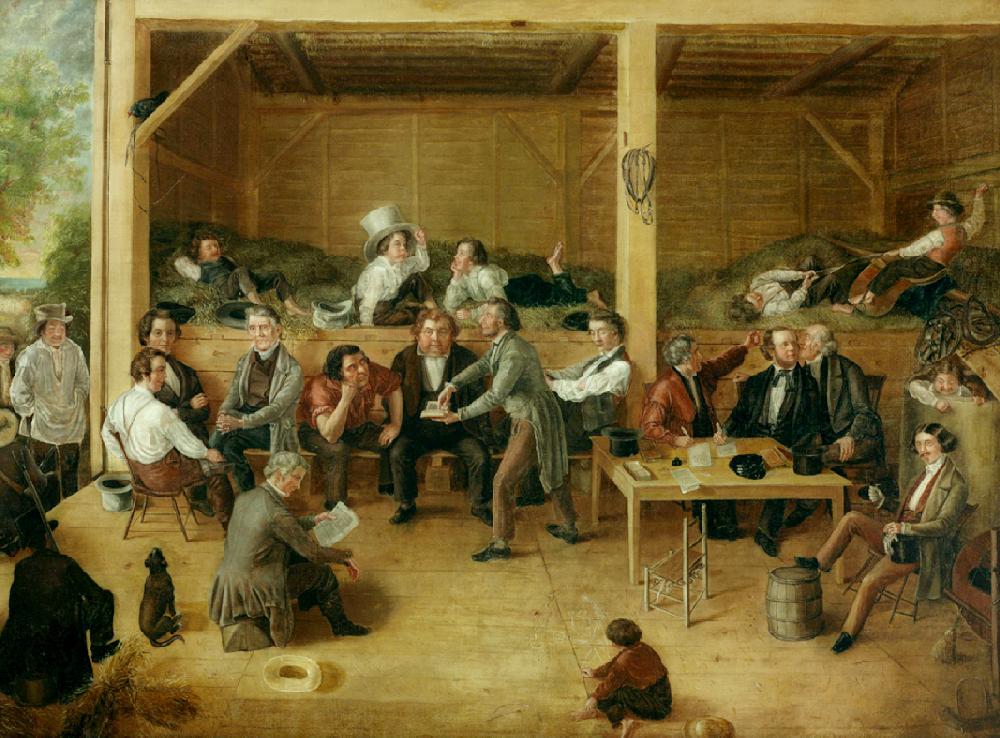
History of Law: Trial by Jury

Figure 1.--Jury trials today take place in the hushed and decorous circumstances of courthouses. This was not the case in trials held in much of 19th century America. Here we have a depiction of a 1849 wihout all the modern trapings. We do not know where it was taken, but would guess it was somewhere in what at the time was the midwest, perhaps Ohio, Indiana, or Illinois. There was not a courthouse, the trial is taking place in a barn. Notice the boys playing in the hay which no one seems to mind. Also notice a farmer wearing a smock watching the proceedings.
But what clearly connects us to modern times is the defendent (the shady person leaning back in the Windsor chair), judge, lawyers, and above all the jury, in this case a six man jury. We have no idea whoi the artiusts was. It is signed A. Wighe, but this almost certainly a pseudonym for “a Whig,” declaring an affiliation with the then important Whig Party. This work was completed just after the 1848 presidential election won by the Whig candidate Zachary Taylor, a slave-holding Southerner. Whigs from the North and South soon became bitterly divided over slavery giving rise to the Republican party in the North. The museum housing the painting suggess that the painting 'may represent an effort to deflect attention toward the less serious or troubling affairs of the time'.
|
|
The trial by jury is a major feature of Anglo-American jursprudence. The jury was not commomn in the ancient world. We do notice jury trials in ancient Greece. The origin of the jury trial appears to be a custom of ancient Germanic tribes. The jury system which developed in medieval Germany was supressed as the modern German states formed. Rather that citizen juries, state appointes justics decided cases. But the Anglo-Saxon tribes that invaded Britain after the departure of the Romans brought that custom to medieval England. This began the development of English common law, including the jury. Jury trials were estblished before the Normans. King Æthelred the Unready issued a legal code at Wantage, which requites that the twelve leading thegns (minor nobles) of each wapentake (an administrative district) were required to investigate crimes without bias. The Vikings for their part added to the tradition. While not pilaging, the Viklings seem t to have been a litigious lot. And the Normans added to this tradition. The Plantagenets also added to the tradition. King Henry II played a major in the development of English law and this included the jury system. He established a system to resolve land disputes using juries. And most famously, trial by jury of one's piers was enshrined in the Magna Carta--at least for nobels. Only gradually was it extended to commoners. Rather trial by ordeal was common. The Church playd a major role in ending that. Over time in Englnd the jury emerged as a safeguard for the criminally accused (17th century). Blackstone described the jury as the 'strong and two-fold barrier ... between the liberties of the people and the prerogative of the crown'. He claimed that the 'the truth of every accusation ... [must] be confirmed by the unanimous suffrage of twelve of his equals and neighbors indifferently chosen and superior to all suspicion.' [Blackstone] The relative isolation of the American colonies, especially durung the English Civil War (17th century), meant that the colonists were on their own. And as there were few trained jurists and those thar did exist were not well respected, having royalist backgrounds and loyalties. As a result, the principle of trial by jury became even more entrenched in American law than it was in England. Ironically one of the English soldiers involved in the Boston Masacre was exonerated by an Amnerican jury. Jurries were such an important feature of American justice that it was not only guaranteed in the constitutions of the 13 original states, but inshrined in the body of the Federal Constitution and in the Bill of Rights (Sixth Amendment). Trials in 19th century America could be rough and ready affairs as we see here in 1849 (figure 1). Lincoln tells some great tales about his exoeriences as a trial attorney. But wherever they were held and whatever the ciurcumstances, the jury would be there to decide guilt and innosence. And the constitution of every new state entering the Union thereafter in one form or another protected the right to jury trial in criminal cases.
Sources
Blackstone, Willim. Commentaries on the Laws of England (1765).
CIH

Navigate the Children in History Website:
[Return to the Main law history page]
[About Us]
[Introduction]
[Biographies]
[Chronology]
[Climatology]
[Clothing]
[Disease and Health]
[Economics]
[Freedom]
[Geography]
[History]
[Human Nature]
[Law]
[Nationalism]
[Presidents]
[Religion]
[Royalty]
[Science]
[Social Class]
[Bibliographies]
[Contributions]
[FAQs]
[Glossaries]
[Images]
[Links]
[Registration]
[Tools]
[Children in History Home]
Created: 6:49 AM 9/22/2018
Last updated: 6:49 AM 9/22/2018



